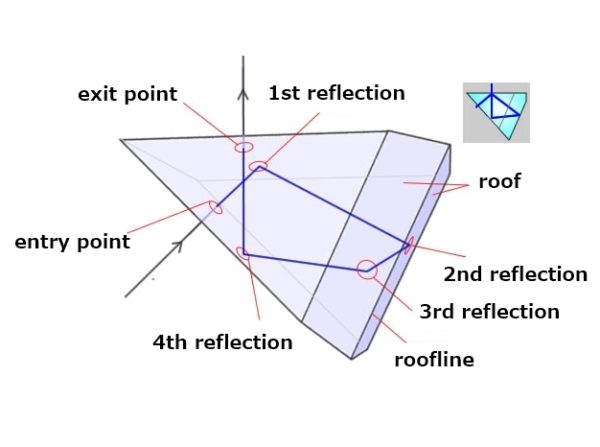When you look at binoculars for sale, you’ll notice there are two types: traditional, chunky ones and slim, stylish ones.
The big, conventional ones that you might see in cartoons are called Porro Prism binoculars. The other, slim types are called Roof Prism binoculars, or Dach Prism binoculars in German.
As the name implies, roof prism binoculars are characterized by a roof-shaped part. Surprisingly, the Roof Prism design already existed in the late 19th century, only a few decades after Porro Prism binoculars were invented.
Recently, Roof Prism binoculars have become more popular than Porro Prism because of their stylish design. In this post, I will explain with photos how Roof Prism binoculars work.
What’s inside Roof Prism binoculars?
There are a few types of Roof Prism designs, such as Abbe-Koenig and Schmidt-Pechan. Each design has its advantages, but the Shmidt-Pechan Prism design is most commonly used in binoculars.
Here is the optical path of Roof Prism binoculars (Schmidt-Pechan design). Notice that the reflections are quite complex here.

A prism is installed beyond the objective lens.
In this diagram (below), there are apparently three reflections in the Shmidt prism, but in reality, four reflections occur.

The Shmidt prism has a roof where the image is rotated 180 degrees and flipped horizontally at the same time. This enables the manufactures to make the binoculars more compact.

These prisms play an important role by rotating the image 180 degrees to get an upright image.

Since there is light going directly to the roofline, which cannot be reflected, the narrower the roofline, the better. Also, the manufacturers need to smooth out the burr perfectly, which takes extreme precision.
Here are some pictures to help you understand the difficulty in making Roof Prisms.
This picture is taken facing one mirror. The image is flipped horizontally.

The next picture is facing two mirrors, combined like a roof prism. The image gets rotated 180 degrees and flipped horizontally twice (back to normal).


If the angle of these mirrors is less than 90 degrees, the center of the image is lost.

On the contrary, if the angle is more than 90 degrees, the image gets separated.

As you can see, the angle of the roof part must be exactly 90 degrees. The angle must be accurate within 0.0089 degrees, which brings manufacturing costs up.
While the roof prism design is very useful for keeping the path of light straight and making the image right-side up, producing roof prisms require more specialized manufacturing techniques at a higher cost.
Which is better, Roof Prism or Porro Prism?
In Porro prisms, light is reflected by ‘total reflection,’ which means no loss in light transmittance. However, in Roof Prism binoculars, total reflection cannot occur in the second reflection of the Shmidt prism, because the angle of light is less than the incident angle.
Therefore, the roof part has to be coated like a mirror, which leads to a loss of light transmittance. This is a major drawback of Roof Prisms.
For many good binoculars, silver mirror coatings are applied for high reflectivity, although the cost is high in lost light. These days, some optical manufacturers use dielectric prism coatings, which enable an amazingly high reflectivity of more than 99%.
The second major problem with the Roof Prism design is the phase shift that occurs after multiple internal reflections. The phase shift causes less contrast and lower resolution.
Looking at a streetlight through an old pair of roof prism binoculars (below), you’ll see annoying ghosts.

To prevent this and increase the contrast, some well made binoculars use phase-correction coatings, which do not allow interference to happen. This phase shift does not occur with Porro Prisms.
Because of the above-mentioned reasons, good Roof Prism binoculars can be very expensive. The main advantage of Roof Prism binoculars is their slim and compact body.
However, as manufacturing techniques dramatically improve, Roof Prism binoculars are becoming less expensive. With larger binoculars, Porro Prisms are heavier than Roof Prism binoculars.
In my opinion, as the aperture gets larger, Roof Prism binoculars have an advantage because of their relatively lightweight. When I look up at the night sky with my 7×50 Porro Prism pair (over 1 kilogram), my arms get fatigued pretty quickly.

Left: 8×42 Roof Prism (the Schmidt Pechan), Middle: 7×42 Roof Prism (the Abbe-Koenig), Right: 8.5×44 Regular Porro.
On the contrary, with compact binoculars, the Mini Porro Prism designs have an advantage over Roof Prisms in most aspects. Mini Porro binoculars are already compact and light, and they are much less expensive than the Roof Prism design.
Summary
There are two types of binoculars: Porro Prism and Roof Prism binoculars. Roof Prism binoculars are also called Dach Prism in German. With Roof prisms, the optical path becomes straight, which makes the body slim and compact.
However, Roof Prisms are more expensive than Porro Prisms not because of their great performance but because of the difficulties in precision manufacturing.
While Porro Prisms enable all light to be reflected through ‘total reflection,’ the Schmidt Prism design has one reflection point, in the roof part, which causes less light transmittance.
Moreover, the internal reflections can cause interference, which can have a negative effect on the image.
If you are not sure which to buy, Porro Prism or Roof Prism, it may depend on the aperture. For large binoculars, the light weight of the Roof Prism design is a major advantage. However, compact binoculars are already light enough, so they do not need expensive roof prisms.
Both Porro and Roof prism designs have advantages and disadvantages. It’s important to know the differences before buying binoculars.
